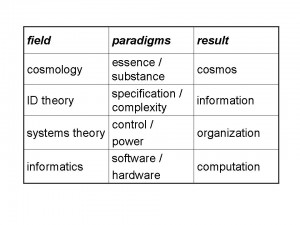How to distinguish organization from simple order? One of the many ways is to note that usually organization implies two paradigms at work: control and power. Power is potentiality, energy, mass, whatever can provide or transmit stuff and work. Control is what is able to govern, manage, drive, lead, regulate power. Order never implies control and power. Compared to organization, order is trivial, and between them there is a real qualitative gap.
Note that – only seemingly paradoxical – the relationship between control and power can be seen as a relation between what is active (control) and what is passive (power). Don’t be surprised I consider passive the power. Power without control is useless and may be even destructive of organization. Unguided potentiality, energy and mass means blind force, whose effects may be unpredictable and devastating. Likewise, action without knowledge is blind and can be dangerous.
Human organizations (states, agencies, industries…) are of course examples of organization. Their power is the human resources, their control is the management. Artifacts, devices, machines, systems are technological examples of organization. All biological systems (from cells to organisms) eminently use the control paradigm. Many alarm-repair mechanisms of life belong to the control-power paradigm. Michael Behe, in “Darwin’s black box”, tens of times stresses the concept of control/regulation. I remember una tantum:
The essence of cellular life is regulation: the cell controls how much and what kinds of chemicals it makes; when it loses control, it dies. (pag. 191)
Relations with ID theory.
“Control” is related to specification, “power” is related to complexity, as meant in the concept of complex specified information (CSI). In fact, complexity refers to a multiplicity of stuff, that, per se, is not sufficient to infer design. It takes specification to overlap a pattern on the complexity and get CSI. This is somehow similar to what control does on power.
Relations with traditional cosmology.
“Control” is related to Essence/Quality, “power” is related to Substance/Quantity, as the basic generating principles of the cosmos. Aristotle called these principles form / act and matter / potency. The laws of the cosmos are essentially controls on the substance. The fine-tuning of the laws is control of control, so to speak. From this point of view the cosmos as a whole is the greatest example of organization.
Relations with informatics.
In a sense we could see “control” as related to software and “power” as related to hardware.
We can summarize all that with the table:
N.B. Control/power has to be meant basically as relationship. Example: a car has an engine and several systems dedicated to control it. The car engine can be, yes, related to “power”, while the control systems are related to “control”. But this neither means that the engine is pure energy (the engine is just per se a complex design), nor that the control systems are pure abstract management (they need energy to work). Analogously, while software/hardware is – relationally speaking – control/power, hardware is just a very complex system, not brute substance; and software is not purely abstract and needs however a physical carrier. At a different level, in a sense, we could find again the control/power pair in the software itself, in the distinction between program and data.
Control vs. power, complementary and hierarchical.
One could see control/power as complementary and interdependent. In fact they can help each other. Control helps to regulate power. Power helps to supply energy to the control systems. In another sense control/power are hierarchical, like – at the level of principles – essence is higher than substance. From this viewpoint – symbolically speaking – control is vertical, while power is horizontal. I will return on this point below.
A practical example of organization in an artifact: clothespin.
Despite being one of the simplest artifacts, a clothespin just shows clearly the two aspects of organization. Power is the metal spring, with its mechanical potential energy. Control consists in its two arms, which are able to drive the energy deployment of the spring. (By the way, these three parts form an irreducibly complex system.)
Another example of organization: bicycle.
The pedals and chain transmit the power provided by the cyclist. The handlebar controls the direction. The brakes control the power’s intensity (by decreasing it). This way the power is like a vector controlled in both magnitude and direction. Also the bicycle frame can be considered part of the control sensu lato, insofar as it supports the power.
I’ll let the readers find in all fields other examples of organization and distinguish in them the aspects of control and power.
Why chance and necessity (C&N) cannot create organization, while intelligence can.
C&N can create simple order. Example: when water ices crystals form. Crystals are ordered sets of atoms/molecules. Differently, C&N cannot create organization. One of the reasons C&N cannot do that is because organization involves control on power.
Intelligence, among other things, is what performs control on power. In fact intelligence implies choice among possibilities, selection between alternatives, foresight of events, goal-directed behavior, purposefulness, recognition of patterns, the ability to anticipate or predict outcomes, etc. All such capabilities can well be synthesized under the word “control” (of possibilities, alternatives, events, goals, patterns and outcomes). In a single word, intelligence is organization. The Aristotelian passage from “potency to act” means quite the same thing, the action of design/organization on matter, the fiat lux of essence on substance, the ordo ab chao producing the cosmos.
What intelligence does when designs artifacts? Intelligence “projects” or “mirrors” organization on matter. We could say there is a mathematical isomorphism between the abstract idea in the intelligent designer and the material artifact implementing the idea. A similar isomorphism exists between an image and its light source.
From a certain perspective, organization, with its control-power binomial, is a hierarchical concept. Control on power means that something overarches something other. Intelligence too is a hierarchical concept because implies the knower-known and agent-acted couple. Knower on known means something overarching something other, in the relation of knowledge. Likewise, agent on acted means overarching in the relation of action.
This is the reason why intelligence is capable to impress the control-power paradigm upon matter. Intelligence outputs something it contains inside itself and inputs it into matter, which receives it as an imprinting.
Why C&N can do nothing of the sort? C&N doesn’t contain in itself the couple control/power. Consequently C&N cannot output it into matter. A thing can give only what it potentially owns. C&N cannot imprint in matter what it has not.
Another method to infer design.
As a consequence of what said above, we IDers have an additional tool for design inference, which could be useful in many cases. When, analyzing a system, we find the control/power paradigm implemented, we can be sure that such system was designed. Differently from the classic CSI method, this one doesn’t need calculations (how to calculate the CSI bits of the clothespin?). Rather, as the method based on Irreducible Complexity, it is focused on the particular functionalities of the system’s parts. Of course, I said “additional” because no one thinks to dismiss the older functioning approaches. Design inference is a thing that can be considered from many perspectives. The control/power viewpoint is one of them, and as such my proposal is to add it to the long “research to do list” of the ID movement.

